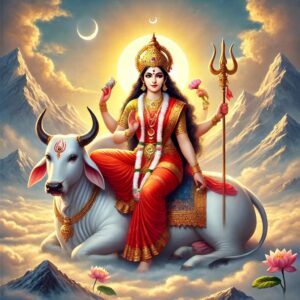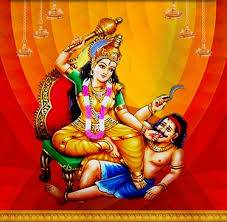Maa Shailputri, also known as Sati or Parvati, is the first of Goddess Durga’s nine forms, referred to as Nav Durga. Worshipped on the first day of Navratri, she represents purity, strength, and the universe’s foundation.
Her name “Shailputri” means “Daughter of the Mountain,” emphasizing her lineage as the daughter of the Himalayan King and emphasizing her connection to nature and the land.
The Legend of Maa Shailputri
Maa Shailputri is considered to be a reincarnation of Goddess Sati, Lord Shiva’s first consort. According to Hindu mythology, Sati was born as King Daksha’s daughter. However, she committed herself after Daksha ridiculed her husband, Shiva, at a great yagna.
Sati reincarnated as Shailputri, the Himalaya King’s daughter, in her next lifetime and wedded Lord Shiva once more. This represents her unwavering devotion and the holy unification of Shakti (energy) and Shiva (consciousness).
Iconography
Maa Shailputri is pictured riding a bull named Nandi, which represents patience, diligence, and the earth’s anchoring vitality. She holds a trident (Trishul) in her right hand, which represents action, courage, and the eradication of evil. In her left hand, she holds a lotus, which represents purity, spiritual awakening, and cosmic energy.
Her appearance is modest but majestic, expressing the purity of nature and her close relationship with the physical world. Devotees are inspired by her magnificent form to feel peaceful and strong.
Spiritual significance
Maa Shailputri is related with the Muladhara Chakra, the root chakra that serves as the foundation of the spiritual energy system. The Muladhara Chakra controls survival, stability, and grounding, all of which are necessary for spiritual development.
Devotees who worship Maa Shailputri hope to enhance this energy Centre, laying a solid basis for their spiritual path. Her worship is also thought to promote emotional equilibrium, bodily well-being, and a stronger connection with nature. Maa Shailputri’s blessings assist overcome uncertainties, fears, and mental disorders, providing a solid foundation for ascension to higher levels of consciousness.
Navratri Worship
Navratri, the nine-day celebration dedicated to the nine manifestations of Durga, starts with the adoration of Maa. On the first day, devotees seek her blessings by offering red flowers, fruits, and cow’s ghee. The cow, which represents cleanliness and nutrition, is also venerated in relation to her. It is thought that offering ghee on this day promotes physical health and lifespan.
Her mantra, repeated during prayers, is “Om Devi Shailputryai Namah”.
Chanting this mantra with devotion invites the Goddess’ blessings, bestowing power, courage, and determination upon the devotee. On this day, devotees begin their journey of self-purification by seeking Maa Shailputri’s blessings to cleanse their bodies and souls.
Connection with Nature
Maa Shailputri’s form and origin are intrinsically linked to nature. As the Himalayas’ daughter, she represents earth energy and nature’s grounding strength. Her devotion encourages believers to appreciate and care for the natural world, and her blessings inspire them to live in harmony with it.
Maa Shailputri’s Modern Relevance
In today’s society, where people frequently confront stress, anxiety, and instability, worshipping Maa Shailputri provides as a powerful reminder of the significance of grounding oneself. Her form emphasizes the importance of remaining linked to one’s roots and maintaining inner stability in the face of life’s hardships.
Her relationship with the Muladhara Chakra inspires people to priorities their physical and emotional well-being. By requesting her blessings, devotees can acquire inner stability, resilience, and the strength to face adversity.
Thanks and Regards
Astro Ritu Bhatia

An experienced astrologer with over 7 years of expertise in guiding individuals through the wisdom of the stars. My knowledge spans both Western and Vedic astrology, Tarot, and Angel healing. I can provide personalized insights and predictions that help users navigate their personal and professional lives. I specialize in birth chart analysis, future predictions, and relationship advice. Throughout my career, I have assisted countless individuals in making informed decisions and finding clarity in their journeys. My approach is user-focused, offering clear, accurate, and compassionate guidance. I’m committed to helping others with astrology in a meaningful way, empowering them to unlock their potential and achieve their goals.










